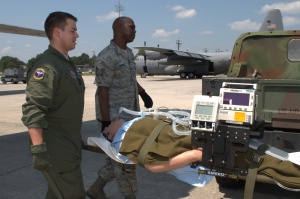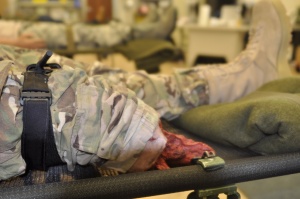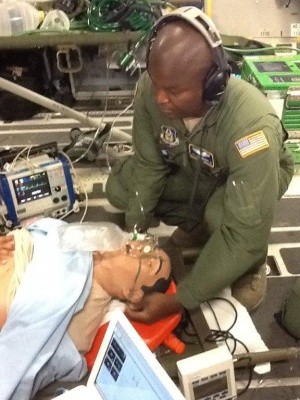
Article: C. E. CORLISS (UNITED STATES)
Aeromedical Evacuation Simulation Training
As training resources and time become increasingly scarce new training methods and venues must be utilized to ensure mission readiness of Aerovac units to Airlift Wounded Warriors. The 94th Aeromedical Evacuation Squadron of the US Air Force Reserve Command is integrating simulation into initial and continuation training for flight nurses and flight medics. These simulations include not only classroom and simulation lab training but live flights with simulators flown onboard training missions as patients in need of care.
The US Air Force is utilizing simulators to train aircrews. This is not new is it; after all the aviation industry has been utilizing simulators since 1927 when the US Army Air Corps purchased six (6) LINK trainers to train pilots to deliver the mail, effectively starting the simulation industry. These simulators however, are being used by the Aeromedical Evacuation Crew Members (AECMs) to simulate our patients as we train to “Airlift the Wounded Warrior”.
 Members of the AES move a ‘critical iStan patient’ from a C-130 to the awaiting HUMVEE during a
training mission
Members of the AES move a ‘critical iStan patient’ from a C-130 to the awaiting HUMVEE during a
training mission
What is simulation? One definition is: “A Device or exercise that enables a participant to reproduce or represent…A method to teach the application of critical thinking skills, communication and team interactions; Risk Free learning”. In medical simulation it supports clinical decision-making – not just a task trainer; simulators provide the ability to train high-risk, low frequency clinical events without risk to patient safety. The US military entered combat operations more than 10 years ago with a routine stateside Aeromedical Evacuation (AE) mission and large fixed Air Force medical treatment facilities. These were the cores for training our air force medics the skills needed to keep the promise to every service member who enters combat…Our promise has always been: Fight bravely and fiercely and if you are wounded we will provide you care unmatched in the world. And we have kept that promise. Training to do so has been a challenge. To provide a comparison look at the average for a US level 1 trauma center compared to the US Air Force Theater Hospital (AFTH) in Balad, Iraq.
TABLE 1
Table 1. Level 1 Trauma Center vs AFTH
Level 1 Trauma Center | USAF Theater Hospital |
4,000 admissions per year | 8,000 admissions per year |
Less than 30% penetrating trauma | Greater than 90% penetrating trauma |
Less than 10% require surgery | Greater than 80% require surgery |
Single procedure/Surgeon | Multiple procedures/Specialists |
During Operation Iraqi Freedom (OIF) the USAF air evacuation system was conducting more than 10,000 patient movements a year. These were a mixture of medical and trauma with ‘stabilizing’ Poly-Trauma cases being the majority. AECMs used this system for currency and proficiency of qualified flight nurses and med techs and to train new crewmembers. With the drawdown of OIF the AE system has decreased to around 200 patient movements per year. And the stateside AE mission and military medical treatment facilities no longer exist – so how do we maintain the training to ensure we will always keep that solemn promise to airlift the wounded warrior – SIMULATION.
In reality how much training can be expected from virtual reality…or at least plastic reality. Well the simulators in use today are far more than the plastic manikins used by the Aeromedical Evacuation Squadron (AES) just a few years ago. The 94 AES located at Dobbins Air Reserve Base is using the CAE Healthcare iStan human patient simulator for aeromedical readiness missions (ARMs). ARMs are flight-training missions conducted to provide the AE crew currency in aircraft systems and operations and proficiency the treatment in a wide array of patients that can be encountered in the AE flight environment.
 CAE Healthcare iStan in the ASTEC with
MetiFX applied for simulated IED amputation –
Combat Tourniquet Application Training
CAE Healthcare iStan in the ASTEC with
MetiFX applied for simulated IED amputation –
Combat Tourniquet Application Training
What is iStan and how is he being used to train? iStan is a wireless tetherless High Fidelity Patient Simulator (HFPS) capable of producing automatic physiological responses to therapeutic interventions with minimal input form an instructor. iStan is a ruggedized ultra real HFPS with an unmatched set of clinical features: its integrated physiology reacts to cardiovascular changes, such as bleeding, as a human patient would, with altered blood pressure, heart rate and other clinical signs. iStan is prepared with moulage and manifested on each AE training mission conducted. According to SMSgt Paula Foust, Superintendent of Nursing Services, “The use of simulation for training is an excellent tool for Aerovac use. We used to have to ask an instructor “so know what is the patient doing”, now you actually see the patient response and are more focused on the care of that patient and his treatment.” The injuries that are being treated each day on real world Aerovac missions are perfectly simulated during the routine training flights. Prior to the introduction of the iStan, AE crewmembers would “pretend” to be patients however, training of the critical assessment and technical skills was restricted based on the limited number of hands on skills that could be preformed. Today the patients iStan simulates are programmed with a full spectrum of scenarios and the moulage is realistic; actual chest tubes, intubated patients, amputations. This level of realism provides a controlled and reproducible training environment. This is a key to maintaining readiness; there is no other training venue available to ensure that these crews receive exposure to the complexity and severity of injuries encountered in combat environment than the iStan HFPS provide. The CAE Healthcare iStan was the first HFPS to receive an Aeromedical Air Worthiness Certificate from Air Mobility Command and declared “Safe-to-Fly” for the C-130, C-17 and KC-135 which are the primary airframes used for aeromedical evacuation. Since they ‘reported for duty’ in 2008 the iStan simulators have logged hundreds of flight hours with the 94 AES providing unmatched training to its AECMs.
The use of the HFPS on the aircraft is large part of the 94 AES training but it’s not the whole story. Over the past year the 94 AES has conducted a Gap-Analysis into initial and continuing education for its medical crews. The AES flight nurses and medics are professionals with great initial training and clinical skills. However, the ongoing training of these crews is often difficult. To correct the training gap the 94 AES has recently stood up the ‘Aeromedical Simulation Training and Education Center’ (ASTEC). The ASTEC is the first of its kind simulation lab for USAF aeromedical crews. While simulation labs are becoming more common for Air Force ground medical units this is the first to be designed to specifically train for the AE enroute care environment.
 iStan ready for a quick look evaluation in
the ASTEC EP Lab
iStan ready for a quick look evaluation in
the ASTEC EP Lab
The ASTEC is a 2000 square foot training area consisting of the main simulation lab (SIM Lab), the clinical skills lab, the emergency procedures lab and a control area. The main simulation lab houses 5 HFPS; 4 CAE Healthcare simulators (2 iStans, 1 MetiMan Nursing and 1 MetiMan Pre-hospital) and 1 Gaumard HAL. The SIM lab is an area to focus on crew coordination and patient safety scenarios. This area is also set for training a variety of courses to include; Basic Life Support (CPR), Advanced Cardiac Life Support, EMT refresher, Pre-Hospital Trauma Life Support, Trauma Nurse Core Course and others. Besides the 5 HFPS stations this area also includes a multimedia area for training and debriefing. This area incorporates a number of computers and Qwizdom audience response systems to provide for interactive learning to facilitate discussion and judge learner understanding. The main lab also contains a variety of AE specialty equipment such as the newly employed stanchion litter system allowing the crews hands on practice with new equipment prior to using it in flight. The clinical skills lab utilizes a variety if part task trainers from IV arms and suture material to catheterization trainers. This area provides a place to practice routine clinical skills and validate those skills during the Readiness Skills Validation Program. The emergency procedures lab (EP Lab) is a smaller simulation area designed to replicate the AE environment of care. The EP Lab houses an iStan in a C-130 litter tier, aircraft web seating inflight medical kits and equipment and all the aircrew life support and aircraft safety equipment found on the C-130. This lab also contains smoke generators and simulated fire machines and allows for individual evaluation of patient and aircraft emergency procedures. This lab is also used for mission rehearsals, crew team building and communication training. The EP lab is connected to a CAE Healthcare LearningSpace Simulation Center Management System that allows each scenario to be recorded and played back during debriefings or to allow other crews to observe training demonstrations. The ASTEC utilizes well-planned and executed simulated scenarios to integrate team training, aviation and patient safety and communication skills. Criteria checklists are documented and debriefing accomplished. The local Aeromedical Staging Facility is included to enhance training through the entire spectrum of enroute care.
There is an old proverb that says “Tell me and I will forget; Show me and I may remember; Involve me and I will understand”. That is the heart of simulation program for the aeromedical evacuation squadron. SMSgt Foust also believes that the use of simulation will aid in the retention of learning for the enlisted medics as they become more immersed in the scenario. Research into in adult learning has shown the following retention:
Table 2
Table 2 Adult Learning Retention
5% | Lecture |
20% | Audio/Visual (Death by PowerPoint) |
30% | Demonstration |
75% | Learn by Doing – Basic Simulation |
90% | Collaborative Simulation (Teach Others) |
 SrA Matthews cares for his ‘patient’ during an
emergency aboard a C-17 AE training mission
SrA Matthews cares for his ‘patient’ during an
emergency aboard a C-17 AE training mission
Beside the benefit of learner retention the AES is always focused on patient safety. It has often been referred to as the ‘practice of medicine’ and that is not acceptable to the flight nurses and medics of the AES. Above the door as you leave the ASTEC it reads: “Out here it is NOT practice.” “It’s OK to make a mistake in here, that is why we do this, we can make the mistake on the manikin and learn from that; we don’t make mistakes with our troops” said Foust. A risk free learning environment allows us to challenge ourselves we
The use of Simulation in the ASTEC provides an immersive training environment that includes very realistic clinical scenarios using CAE Healthcare Fidelity Patient Simulators. Then we incorporate the simulated aircraft environment; now we can fully simulate onboard missions and emergencies. When you are inside the sound, the feel, the environment is realistic and we are able to challenge the crews with highly complicated missions that are modeled on actual missions and challenging patients who have returned from combat environments. Now add iStan as a patient on the actual in-flight training missions. Training like this is providing an aeromedical evacuation capacity unrivaled anywhere in the world and saving lives. As the current operational and fiscal environments continue to constrain and limit training venues the ASTEC will continue to explore ways to enhance training and readiness with simulation. This will ensure that the flight nurses and medics of the 94 AES continue to keep THE PROMISE and ‘Airlift the Wounded Warrior’.
Author
CHAD E CORLISS, Maj, USAFR, NC, SFN
Maj Corliss is currently the Director of Operations for the 94 Aeromedical Evacuation Squadron and the Aeromedical Simulation Training and Education Center
Address of the author:
94 AES/DO - Maj Corliss
1552 Warehouse Rd Bldg 744
Dobbins ARB, GA 30069
Email: [email protected]
Commercial Phone 678-655-4823
Date: 01/14/2019
Source: Medical Corps International Forum (3/2012)











